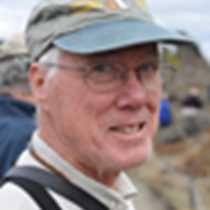Deception Island & Lindblad Cove, Antarctica
We have seen Antarctica at her brightest: the morning light at Brown Bluff shining on clean, white breasts of Adelie penguins as they return to their nests from a feeding foray; the evening light in Antarctic Sound illuminating the vertical faces of huge, flat-topped tabular icebergs that have broken off of Antarctic ice shelves. Today we experienced Antarctica in a different light, cloaked in fog, snow, volcanic steam ... and mystery.
Deception Island is a place where Antarctic history is palpable. The South Shetland Islands were discovered by a British trader, William Smith, in 1819. Within two years, even as the British flag was first raised, the beaches were occupied by sealers, English and Yankees from Connecticut, here to collect a rich harvest of the pelts of fur seals. The legacy of the sealers is one of silence. Where once the barks, snarls, and roars of fur seals dominated the beaches during the breeding season, silence now reigns. In only a few years the sealers had finished their business and the seals were gone (or, when the seals were gone their business was finished) and they have still not returned.
It was sealers who discovered the secret of Deception Island, the narrow opening of Neptune's Bellows that opens into the flooded caldera of this active volcano. It is a marvelous harbor. Beginning in 1906, Whalers' Bay, inside the caldera, was by far the most active spot in Antarctica, populated each summer by Norwegians here to harvest the whales and render their blubber into oil. Their product was mostly used to make soap and, during World War I, explosives. The industry ended abruptly in 1932, at least on this side of Antarctica, but its historic legacy remains in the buildings and machinery falling into ruin on the shore of Whaler's Bay.
Volcanic steam around the shoreline, pungent with the odor of sulfur, shows us that Deception Island remains an active volcano. It last erupted in 1967 - 1970, twice forcing evacuation of the British Antarctic Survey base that, beginning in 1944, had taken over the remains of the whaling station. We took advantage of the heat, such as it is, for our "Polar Plunge": a wallow in the warm volcanic cinders followed by a quick dash into the frigid water of the Bay. Proudly, many of us earned our bragging rights; after all, it is a "Once in a Lifetime" experience.
We left Deception Island and crossed the Bransfield Strait to the Antarctic Peninsula Here we entered Lindblad Cove, named for the pioneer of expedition travel, Lars Eric Lindblad, the first to bring adventurous tourists to Antarctica. We are here on the fortieth anniversary of the launching of the first ship dedicated to expedition travel, the Lindblad Explorer. Glaciers descend down the steep slopes that surround the cove, filling the sea with bits of ice of all sizes - brash ice, growlers, bergey bits, and small icebergs.
The falling snow remained on the cold sea as a cloak of white. I don't want to sound overly mystic, but could the solitary juvenile emperor penguin that we encountered on the ice at the entrance to Lindblad Cove represent another legacy, the spirit of Lars Eric Lindblad? It seemed somehow fitting as our ship, a later day Explorer, cruised through the austere beauty of this most incredible place.




